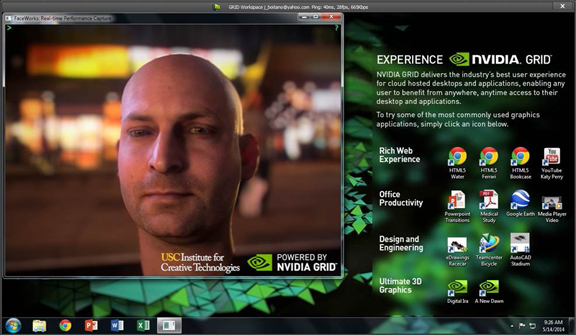Latest News
May 27, 2014
Is it feasible to run professional-grade software using a remote desktop, or a virtual desktop? It’s a scenario that many have proposed as the way of the future, driven in part by the software consumers’ comfort with SaaS and in part by the potential cost reduction in eliminating physical hardware. Last week, NVIDIA launched a service that lets you test it yourself. The NVIDIA GRID test drive is now online.
To run the test drive, you’ll need to register and download a thin client (a 10 MB launch file). Once done, you’ll be able to log in to get 24-hour access to a remote desktop, hosted in a GPU-accelerated GRID server. The tester’s desktop is preloaded with, among other programs, AutoCAD, SolidWorks eDrawings, Google Earth, PowerPoint, and a few multimedia files.
I ran the test using a home user’s ordinary DSL connection. Interactive programs—like eDrawings, AutoCAD, and Google Earth—ran as they normally would on a local machine. With large models, zooming, panning, and rotating could cause stutters on underpowered machines. In the GRID-powered virtual desktop, all worked seamlessly. In multimedia content playback, the HD movie provided by NVIDIA and a clip featuring Dawn, the company’s brand icon, did exhibit some noticeable choppiness.
In previous virtualization exercises, companies managed to successfully duplicate the operations of the CPU in the cloud; however, virtualizing the GPU remained a stumbling block, until NVIDIA’s Kepler architecture made it possible. That means programs that rely heavily on the graphics processor to let you interact with pixel-dense visuals and 3D models (typical of CAD programs with photorealistic display option) can now be virtualized and hosted in the cloud without a loss of graphics performance. The virtual desktop or the remote desktop experience now includes GPU-acceleration.
Some vendors like VMWare, a NDIVIA-partner and a leader in virtualization, is laying the groundwork to deliver Desktop as a Service (DaaS). VMWare’s product Horizon DaaS lets you rent and use remote Windows desktops hosted in the cloud just as you would with any other SaaS products. The emergence of this trend opens up new options previously unavailable to small and midsize businesses that need access to powerful workstation-grade desktops to run engineering software but don’t have the budget to acquire and maintain them perpetually.
For more, watch the video report below:
Subscribe to our FREE magazine, FREE email newsletters or both!
Latest News
About the Author
Kenneth Wong is Digital Engineering’s resident blogger and senior editor. Email him at [email protected] or share your thoughts on this article at digitaleng.news/facebook.
Follow DE






